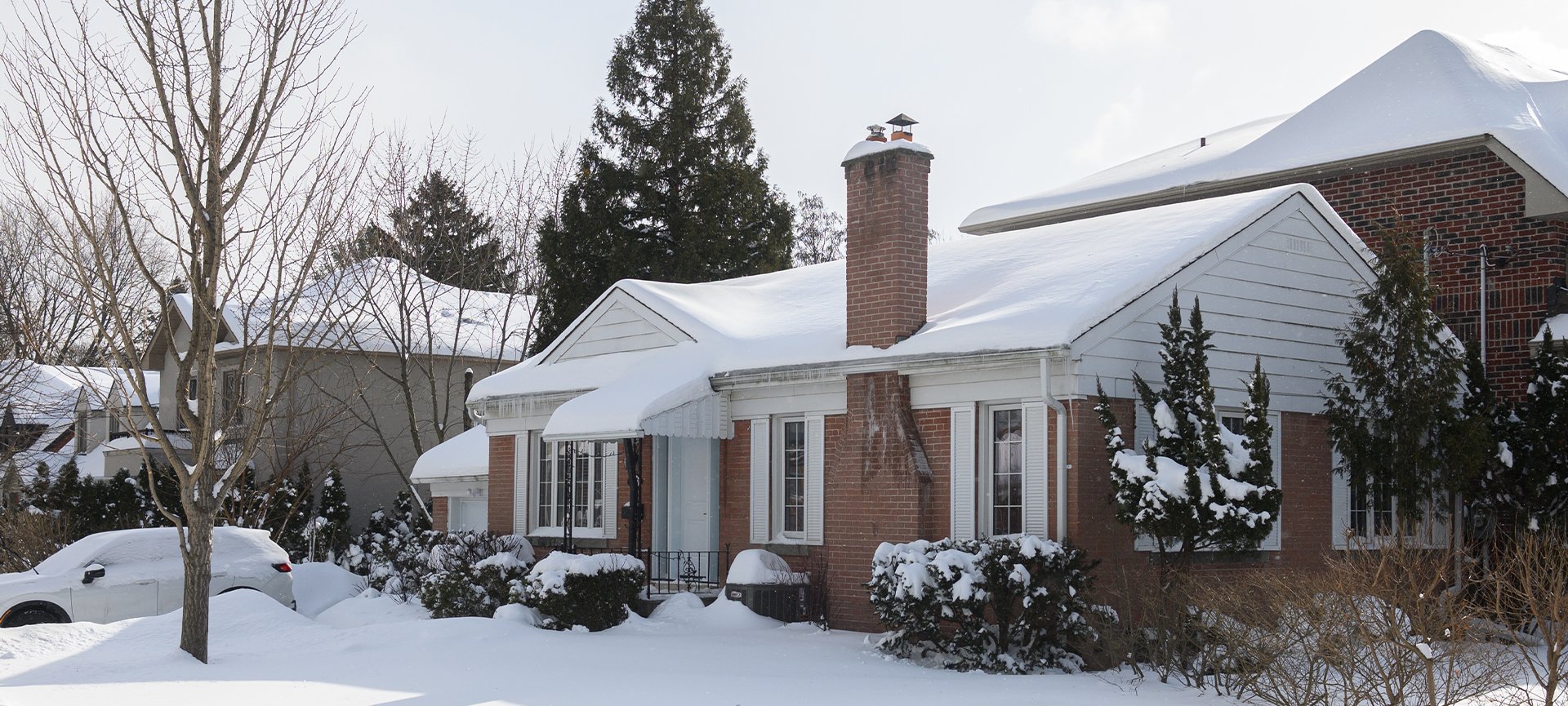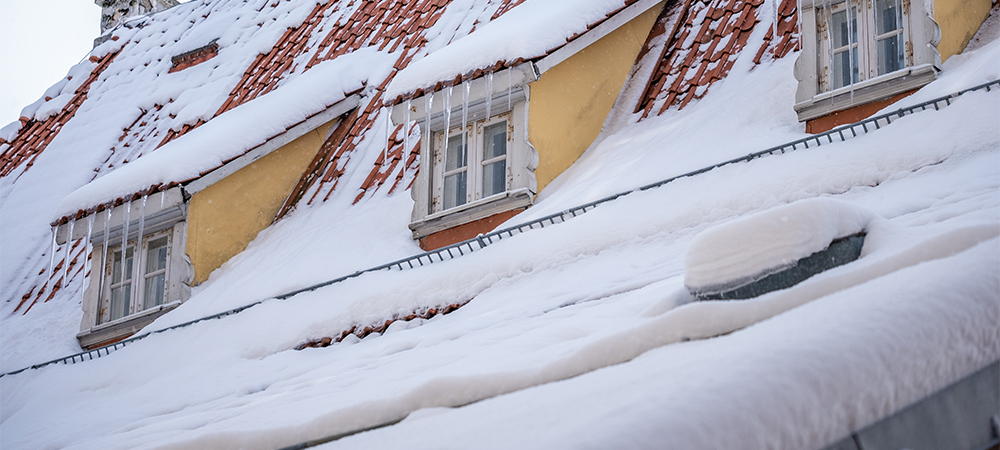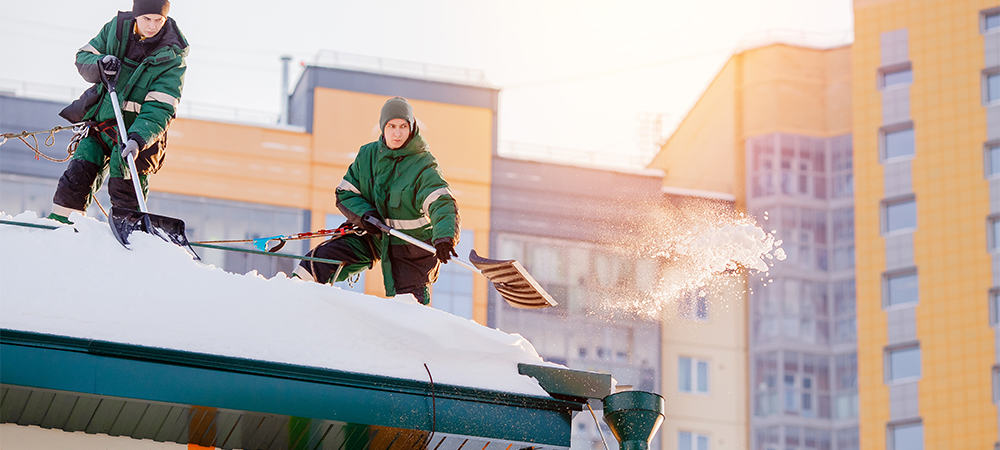How Snow Accumulation Affects Your Building’s Structure Over Time?

Even light, fluffy flakes turn into tonnes of pressure once they pile up. Snow load is the downward force exerted on a structure by accumulated snow and ice. In Canada, codes set minimum design loads, but storms often push those limits. Granular snow at -5 °C can weigh ≈ 160 kg/m²; wet spring snow can double that number.
A roof that safely holds summer sunshine might struggle under a mid-February dump. Flat roofs collect drifts evenly, while pitched roofs funnel snow into valleys that act like funnels, increasing localized stress. Over time, repeated exposure fatigues connections, fasteners, and supports, setting the stage for structural failure.
With that in mind, the next section explains how snow load forms and why every extra centimetre matters for your building’s strength.
Related Article: How to Stop Ice Build Up in Eavestrough
Structural Stress Points: Where Trouble Begins
Snow never presses uniformly. Weakness typically appears at joints, overhanging eaves, and changes in roof geometry. Dormers, skylights, and HVAC curbs break the roof’s plane, creating pockets that trap drifting flakes.
During a thaw–freeze cycle, meltwater finds hairline gaps around these elements and refreezes overnight. Ice expands by about nine percent, prying materials apart. Steel beams can flex back, but brittle masonry may crack. Timber joists swell, compress insulation, and leave less capacity for the next storm.
Long-Term Damage Pathways
Snow affects more than just load-bearing; it changes how the entire envelope behaves.
- Moisture Infiltration
As snow melts, water tracks along joists and screws, bypassing membranes. Persistent dampness encourages mould and rots wood sheathing, reducing its load-sharing strength.
- Freeze–Thaw Cycling
Concrete and brick absorb meltwater. When temperatures dip, trapped moisture freezes, expands, and spalls the surface. Each cycle removes a thin layer, slowly eroding the material until the rebar sits exposed and rust sets in.
- Material Fatigue
Repeated loading and unloading, even within design limits, fatigues metal fasteners and welds. Minor deformation compounds year after year, lowering the safety margin without any obvious warning.
Related Article: Preventing Ice Build-Up: Effective Strategies for Commercial Properties

Warning Signs to Watch For
A mid-storm collapse is rare; buildings send signals first. Pay attention to:
- Sagging ceiling tiles or visible deflection in rooflines
- New cracks in drywall or masonry that widen after storms
- Sticking doors or windows, indicating frame distortion
- Popping sounds as connections shift under stress
- Water stains or icicles forming where they never used to appear
Document changes with dated photos. Progressive issues, not one-off quirks, reveal the true risk.
Preventive Design Strategies
The best defence starts on the drawing board.
Engineers specify roof pitch, beam size, and truss spacing to shed or carry anticipated snow. Snow guards on metal roofs hold drifts until the sun and gravity can disperse them safely rather than dumping large sheets onto lower roofs or pedestrians. Heated gutters and downspouts keep meltwater moving so ice dams don’t form.
For retrofits, increasing attic insulation helps maintain a cold roof deck, reducing melt-and-refreeze cycles. Adding redundant supports under valleys distributes concentrated loads, buying precious capacity during extreme weather.
Schedule a commercial snow removal within 24 hours of any heavy snowfall to keep excess weight from straining the roof and accelerating hidden structural damage.
Maintenance and Snow Management
Even a perfectly designed building needs routine care. Clear drains before winter so meltwater has an escape route. Inspect flashing and sealants every autumn; renew anything brittle or loose.
After heavy snowfall, remove excess weight promptly. On low-slope roofs, aim to leave a thin layer (about 5 cm) to avoid membrane damage from shovels. Use plastic tools and push snow toward the roof edges, never across seams. For pitched roofs, a roof rake used from ground level reduces risk to both workers and shingles.
Professional crews, like the snow-removal team at Green Side Up Contracting, carry fall-arrest gear and understand load-balancing techniques, essential when weight can shift suddenly.
Related Article: Preventing Slip-and-Fall Accidents: The Role of Commercial Snow Removal in Liability Protection

When to Call a Professional
If deflection exceeds L/200 of the span (≈ 25 mm over a five-metre span) or cracks widen after each storm, call a structural engineer. They’ll measure residual capacity, recommend shoring, or outline repair. Early intervention often means reinforcing a beam rather than replacing an entire roof.
Insurance providers may require documented inspections to maintain coverage. Getting expert reports on file strengthens any future claim and speeds approval for urgent work.
Financial and Safety Impacts
Structural failures cost more than repairs. Lost revenue from business interruption, higher insurance premiums, and liability for injuries can dwarf the price of preventive upkeep. In extreme cases, collapse damages neighbouring properties, widening the legal fallout.
Employees and tenants also deserve a safe environment. Reassuring them with a visible snow-management plan enhances trust and can boost lease renewals or staff retention during harsh winters.
Actionable Insights for Long-Term Structural Health
Snow is beautiful on a postcard, but relentless on a building. Understand how weight, moisture, and temperature swings interact with your roof, walls, and foundation. Watch for subtle changes, tackle maintenance on schedule, and bring in experts before minor issues grow.Need help clearing that next record dump? Green Side Up Contracting offers prompt, professional snow-removal and building-care services across the GTA. Book an inspection today and winterize your investment with confidence.
